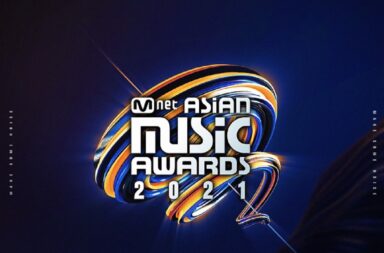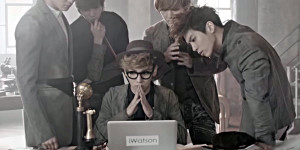 South Korean culture is so easily accessible these days that we almost take it for granted. Every major South Korean entertainment company from Arirang TV to KBS has a channel on YouTube; KBS even subs most of its shows for English, and now Spanish, speakers.
South Korean culture is so easily accessible these days that we almost take it for granted. Every major South Korean entertainment company from Arirang TV to KBS has a channel on YouTube; KBS even subs most of its shows for English, and now Spanish, speakers.
Music videos from famous groups like Big Bang to obscure indie artists like Neon Bunny are widely available. A slew of websites filled with South Korean dramas, variety shows, and movies are always there to give you your fix. K-pop is beginning to turn up in unexpected places like Psy’s performance in Times Square on New Year’s Eve or Microsoft using “I’m The Best” for the Microsoft Surface commercial.
And it’s not just in the United States. My Love From Another Star was watched 2.8 BILLION times on the Chinese streaming site iQIYI. Chinese travelers went as far as London to buy the sparkly Jimmy Choo high heels featured in the series. Former Japanese Prime Minister Junichiro Koizumi said in the 2004 elections that, “I will make great efforts to be as popular as Yon-sama” (Yon-sama of course being the Japanese nickname for Bae Yong-joon from the insanely popular Winter Sonata). Farther up on the raised eyebrow scale are people who teach you how to “look Korean” or white people with Korean names who call themselves “synthetic Koreans.” All of this frenzy for everything Korean begs the question, why? Where did this hallyu wave come from? The reason might surprise you.
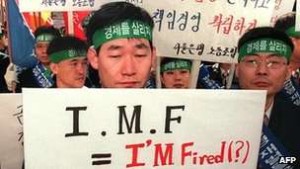 The Asian financial crisis of 1997 caught everyone off guard. Although the exact causes are still disputed, the effects were crystal clear. The problem began in Thailand and quickly spread to other countries as one after another each country’s currency was devalued.
The Asian financial crisis of 1997 caught everyone off guard. Although the exact causes are still disputed, the effects were crystal clear. The problem began in Thailand and quickly spread to other countries as one after another each country’s currency was devalued.
South Korea managed to get a loan for up to $57 billion from the International Monetary Fund in December 1997. Although they needed the money, South Korea refers to this day as the Day of National Humility. It had built itself up from a war-torn nation to the world’s eleventh-largest economy, and South Korea was no longer even considered a developing country anymore. Going back to being a nation in crisis was painful, and President Kim Young-sam was vocal about how ashamed he felt having to borrow money.
If you’re looking for the man behind hallyu, look no further than President Kim Dae-jung. In fact, you might want to include him in your annual sacrifices to the K-pop gods, he was just that important. The incoming president instituted strict reforms, resulting in mass economic upheaval.
Over half of the chaebols (South Korean conglomerates) shut down when the government started regulating banks and the loans they were giving to them. 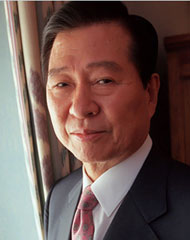 Unemployment and higher interest rates ran rampant. Parents divorced because of the economic strain or even left their children at orphanages. In a desperate move to replenish the nation’s reserves, South Koreans donated their wedding rings, trophies, and other possessions in a gold drive that raised eight metric tons of gold in one week. The crisis and its effects seriously tarnished the country’s reputation, and South Korea was losing foreign investors fast. With exports and investment declining, industries had to make up the lost revenue somehow.
Unemployment and higher interest rates ran rampant. Parents divorced because of the economic strain or even left their children at orphanages. In a desperate move to replenish the nation’s reserves, South Koreans donated their wedding rings, trophies, and other possessions in a gold drive that raised eight metric tons of gold in one week. The crisis and its effects seriously tarnished the country’s reputation, and South Korea was losing foreign investors fast. With exports and investment declining, industries had to make up the lost revenue somehow.
The president decided to literally call a PR firm to change the country’s image and coax investors back. One of his areas of focus was pop culture. Investing in entertainment might seem completely random, but it made sense for various reasons. For example, South Korea has no natural resources and very little arable land. Manufacturing was also not suitable for investment because of high labor costs. In addition, in many countries the military is behind the technological innovations that trickle down to the private sector. Who knew that the GPS technology in your humble smartphone was first used in the 1970s to track nuclear warheads?
With North Korea lurking next door, however, investing in military technology would be suicide for a country still technically at war. So South Korea was left with few alternatives. In 1997 while South Koreans were melting down their wedding rings, Americans were sobbing over Jack Dawson and blasting “My Heart Will Go On” from their  stereos (yes, it has been that long). The president was inspired by how much money the US earned from films and the UK from musicals. Since pop culture really only needs time and talent, building it from scratch was feasible. Apart from the economic benefits, the president was also certain that pop culture would ultimately help unite the two Koreas.
stereos (yes, it has been that long). The president was inspired by how much money the US earned from films and the UK from musicals. Since pop culture really only needs time and talent, building it from scratch was feasible. Apart from the economic benefits, the president was also certain that pop culture would ultimately help unite the two Koreas.
Building a cultural phenomenon takes money, and South Korea was more than willing to invest. In 1999 alone the government increased its entertainment budget six times the original amount. Fast forward to 2012 and $253 million was set aside for cultural development and about another $119 million for the media; only the French government spends more on its culture. South Korea also has a $1 billion fund exclusively for Korean pop culture; it doesn’t even include the fine arts which has its own division. The government, private companies, and banks all contribute to it. That’s a $1 billion safety net that guarantees Shinee will always be back, back, back, back.
Although the government shies away from being called the invisible hand behind K-pop (probably because government involvement and control of culture smacks too much of communism), each president since 1998 has made promoting South Korea’s soft power a top priority. One of the first things current President Park Geun-hye did after taking office was turn a small research group in the Ministry of Culture into the full-blown Popular Culture Industry Division. This division is behind ambitious projects like hologram concerts which can be viewed “live” simultaneously worldwide. Another one of South Korea’s projects is Hallyu World, a cultural theme park set to open in 2016 or early 2017.
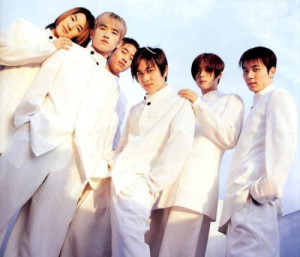 But investment was just the first step; next South Korea needed the people power to carry out world domination. There was just one problem: South Korea didn’t really have a strong pop music tradition.
But investment was just the first step; next South Korea needed the people power to carry out world domination. There was just one problem: South Korea didn’t really have a strong pop music tradition.
SM Entertainment was just a baby at only two years old in 1997; S.E.S. had just debuted that year. YG Entertainment was even younger at just 1 year old, and J.Y. Park was too busy releasing his own albums. South Korea for many years did not really have a musical identity. First there was the Japanese occupation which stifled South Korea’s homegrown music culture. Later on in the 1970s, President Park Chung-hee banned rock music along with short skirts in a harebrained scheme to stop communism.
Euny Hong, who wrote The Birth of Korean Cool, argues that the lack of rock music influences in turn affected pop music, leaving South Korea with disco, synthesizers, and trot songs. The void’s effects can still be seen today in the form of South Korea’s strong ballad tradition. Korean pop music had to basically be made from scratch. So South Korea brought in Europeans to write the songs, hired foreign choreographers, and got people who studied editing in the U.S. This resulted in the heavy electronic and techno influences we hear so much in K-pop today.
The factory-style model used for the music had to be applied to the talent as well because of the harsh realities of being a South Korean teenager. If your day consists of going to school and then to a hakwon to cram in English vocabulary, the periodic table, and calculus, the last thing you’re thinking of is starting a singing career. Unlike other countries, young people simply didn’t (and to a large extent still don’t) have the time to form a band, make music on their own, and get discovered. Plus, pursuing a singing career was a good way to earn a kimchi slap from your mother to knock some sense into you; it was only within the last 10 or 11 years that making a living as a musician seemed doable, let alone a respectable job.
[youtube http://www.youtube.com/watch?v=PtXbLyFtpqA]With the lack of pop music and people willing to risk everything for a dream, the entertainment companies, with government investment, stepped in with their factory system and notorious contracts. Culture critic Lee Moon-won of Media Watch says that South Korea needs this system because the talent pool is smaller. With only 50 million people (compared to the U.S.’s 300 million), waiting around for natural talent to turn up is not practical; companies need to actively recruit and train the talent. Euny Hong goes so far as to claim that no other country could have this system:
“There is another, bleaker reason why Korea has little reason to fear that other countries will try to emulate the K-Pop export model: the star-making process is so unpleasant that there are not many countries whose aspiring stars would put up with it. Korean youth, meanwhile, are used to intense sado-masochistic academic pressure, extreme discipline, constant criticism, and zero sleep.”
Now that the hallyu wave is in full swing, the view of making it a career has also changed. In 2012, 4% of the population (2.08 million people) auditioned for Superstar K. And although everyone criticizes the K-pop training model, it’s not as if choosing another career would be any less stressful. Young people who aren’t singers often end up in equally stressful jobs that require long work hours, little vacation time, and complete dedication to the company. So, if you have the dream and the passion, why not live your life doing something you enjoy?
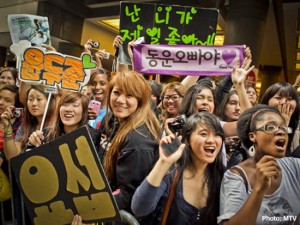 So we have the investment and the talent. Now all that’s left is the hordes of screaming, borderline psychotic, fans. You probably thought that this happened naturally, right? Wrong. Getting fans was another well thought-out process and foreign support was crucial.
So we have the investment and the talent. Now all that’s left is the hordes of screaming, borderline psychotic, fans. You probably thought that this happened naturally, right? Wrong. Getting fans was another well thought-out process and foreign support was crucial.
Countries like Japan have the population and the domestic buying power to keep their pop culture isolated but still profitable. South Korea, however, is too small to do that. Strengthening your soft power can also positively affect other areas like the economy (you know you googled Korea’s magical skin care products, don’t lie). The government has guides that explain the socio-economic, political, and cultural factors that officials and businesses need to keep in mind when expanding overseas. For example, Korean TV programs should avoid airing during prayer times in Muslim-majority nations.
But even with a guide not every country could have the same results. South Korean culture is also appealing because unlike China or Japan it has never invaded anyone. Without the imperialist aftertaste, their culture is seen as less threatening and more relateable. Some scholars say that its traditional Confucian values make the hallyu wave so appealing, particularly in Asia. The Iranian government started buying South Korean dramas because they are usually conservative; Iranians fell head over heels for series like Jewel in the Palace and Jumong. Others argue that this explanation is too simplistic. Cornell University’s Michael Shin says that South Korean dramas have universal appeal because their rags-to-riches storylines reflect the audiences’ experiences and desires. I think the appeal of South Korea is a combination of all of the above.
So there you have it!
Economic turmoil
+frozen Jack Dawson
+lots of cash
+overworked Korean teenagers
+terrifyingly loyal fans
__________________________
Hallyu Wave
 We can thank bad economics and a president inspired by Will Smith’s alien butt-kicking skills for Super Junior’s iconic “Sorry, Sorry” dance and the term “chocolate abs.” Sure, there might have been a small group of non-Korean international fans interested in South Korea, and there certainly would have been singers and dramas. But without that desperate need for investment and revenue, who knows what would have happened? But I’m glad that things turned out the way that they did, because having hallyu around is, well, almost paaradiiise….
We can thank bad economics and a president inspired by Will Smith’s alien butt-kicking skills for Super Junior’s iconic “Sorry, Sorry” dance and the term “chocolate abs.” Sure, there might have been a small group of non-Korean international fans interested in South Korea, and there certainly would have been singers and dramas. But without that desperate need for investment and revenue, who knows what would have happened? But I’m glad that things turned out the way that they did, because having hallyu around is, well, almost paaradiiise….
(The Economist, PBS, Chosun Ilbo, BBC News, Forbes, YG Entertainment, YouTube, Nikkei Asian Review [1][2], CNBC, MinnPost, Hong, Euny The Birth of Korean Cool, Alan Greenspan The Age of Turbulence, images via YG Entertainment, BBC News, New York Times, 20th Century Fox)
